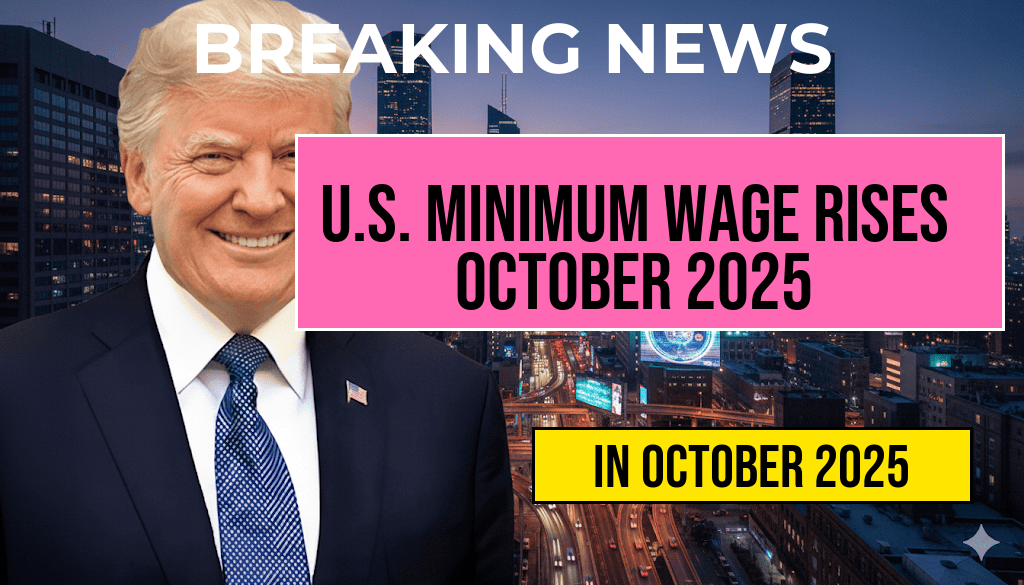The United States will see a significant change in its minimum wage policy starting October 4, 2025, as new federal and state updates come into effect. The Department of Labor has announced that the federal minimum wage will increase from its current rate of $7.25 per hour to $9.50 per hour nationwide. Several states and localities have also enacted their own minimum wage increases, resulting in varied rates across the country. This adjustment aims to address rising living costs and enhance earnings for low-wage workers, though it also sparks ongoing debates about economic impacts and employment levels. Employers and employees alike are preparing for the change, which marks a notable step in the ongoing effort to align wages with economic realities. The updated rates reflect a mix of federal mandates and state-specific policies, creating a complex landscape for businesses and workers to navigate.
Federal and State Minimum Wage Changes Set for October 2025
Federal Minimum Wage Increase
Effective October 4, 2025, the federal minimum wage will rise from $7.25 to $9.50 per hour. This marks the first federal increase since 2009 and is part of a broader legislative effort to improve conditions for low-income workers. The increase was authorized by recent legislation aimed at gradually raising the minimum wage over the next several years, with further increases scheduled for 2026 and beyond. The $9.50 rate is intended to serve as a baseline, with states and localities encouraged to set higher minimums if they choose.
State and Local Minimum Wage Adjustments
While the federal government sets a national minimum, individual states and municipalities retain the authority to establish higher rates. Several jurisdictions have announced their own increases, often tied to inflation or cost-of-living adjustments. For example:
- California will increase its minimum wage to $16.00 per hour for large employers, with smaller businesses reaching $15.00.
- New York will raise its minimum wage to $15.50 in New York City, while upstate regions will see different rates based on local economic conditions.
- Washington will update its minimum wage to $15.74 per hour.
Many other states, including Illinois, Massachusetts, and Oregon, are implementing similar increases, reflecting a broader trend toward higher wages in response to inflation and economic pressures.
Implications for Employers and Workers
Business Adjustments and Economic Impact
Employers across various sectors will need to adjust payroll systems to comply with the new rates. Small businesses, in particular, face challenges balancing wage increases with operational costs. Some industry leaders anticipate marginal rises in prices or restructuring of staffing to offset increased wages. Economists remain divided on the long-term effects; some suggest higher wages may boost consumer spending, while others warn about potential employment reductions or increased automation.
According to a recent report by the Wikipedia entry on minimum wage in the United States, the relationship between wage hikes and employment levels remains complex and varies based on regional economic conditions.
Worker Benefits and Cost of Living
For low-wage earners, this increase offers a tangible boost in disposable income, potentially reducing reliance on social safety net programs. Advocates argue it supports economic mobility and reduces income inequality. However, some critics express concern that smaller employers might cut hours or delay hiring to offset higher labor costs.
Data from the Forbes report on minimum wage effects suggests mixed outcomes across different regions and industries, emphasizing the need for ongoing evaluation.
Updated Pay Rates by State and Localities
| Location | Minimum Wage | Notes |
|---|---|---|
| Federal | $9.50 | Applicable nationwide, with exceptions |
| California | $16.00 | For large employers |
| New York | $15.50 (NYC) | Varies by region |
| Washington | $15.74 | |
| Illinois | $14.00 | |
| Massachusetts | $15.00 | |
| Oregon | $14.75 | Increased in specific counties |
These figures highlight the ongoing shift toward higher minimum wages across the country, with some regions setting significantly above the federal baseline. Employers and workers should stay informed about specific local policies to ensure compliance and maximize benefits.
Looking Ahead
The scheduled increase in the minimum wage for October 2025 reflects a broader societal effort to address economic disparities. While the precise effects on employment and business costs remain under close scrutiny, there is consensus that wage growth plays a critical role in reducing poverty and fostering economic stability. Policymakers continue to monitor the outcomes of these adjustments, with some advocating for further increases, and others urging caution to prevent adverse impacts on employment levels.
For more detailed information on upcoming wage policies and their implications, visit U.S. Department of Labor’s Minimum Wage page or consult local government resources.
Frequently Asked Questions
What is the new minimum wage effective October 4, 2025?
The U.S. minimum wage will increase starting October 4, 2025, with updated hourly pay rates announced across various states and sectors.
How will the minimum wage increase affect employees?
The increase in hourly pay rates will provide higher earnings for workers earning the minimum wage, supporting improved living standards and financial stability.
Which states or regions have announced their new minimum wage rates?
Several states and regions have announced their updated minimum wages, with details available for each jurisdiction to help employers and employees plan accordingly.
Are there any exemptions or special considerations in the new wage rates?
Some exemptions or special considerations may apply based on industry, employer size, or employee classification. It’s important to review local regulations for specific details.
When should employers implement the new minimum wage rates?
Employers are expected to implement the new hourly pay rates starting on October 4, 2025. Employers should review their payroll systems and update compensation structures accordingly.






